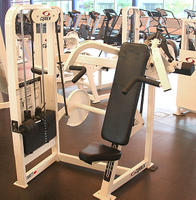 It is only a matter of time: if you work out hard enough, you will eventually overdo it and place yourself on the Disabled List (DL). This has to be one of the most frustrating events that can happen to someone dedicated to fitness. You have in effect been rewarded for your devotion by getting a significant injury. However, all injuries (and how you respond to them) are not created equal.
It is only a matter of time: if you work out hard enough, you will eventually overdo it and place yourself on the Disabled List (DL). This has to be one of the most frustrating events that can happen to someone dedicated to fitness. You have in effect been rewarded for your devotion by getting a significant injury. However, all injuries (and how you respond to them) are not created equal.The Nagging Injury
This is most likely caused by repetitive motion or overuse of certain muscles and/or joints. For example, you may start getting ankles that are getting sore and never seem to get better. It may never reach the point of outright pain, but that is probably on the horizon (see below type of injury). Your body is flashing a very big, red warning sign at you.
This is especially common in people who do not vary their routines or employ any real form of cross-training. You may do activities that are supposedly non-impact such as using an elliptical trainer, but end up with worn out ankles from the hours and hours you spend engaged in its repetitive motion. If this is the case, make sure you vary your routine. Skip the elliptical for a while and hit the bike, treadmill or concentrate on weight training. You also may want to check your equipment. Is it in good working order and stable? Can you vary the angle or intensity? Do you need new workout shoes? A simple change in routine or approach may help in eliminating this injury before it gets worse.
The Pinpoint Injury
One morning, you wake up and a part of your body (shoulder, knee, foot, etc.) does not seem to work like it did the day before. There may be stiffness, pain or swelling, and it is extremely localized and movement specific. The good news is that you can probably work around it until it heals. The bad news is you probably got it from going through your regular routine, and, thus are likely to injure it again if you are not careful.
If you are keeping a good training log (like you should!), go back over the last two weeks and see if you can spot any patterns. Did you add a new exercise? Have you been rapidly (maybe too rapidly...) increasing your resistance or intensity? Are you getting less rest between workouts or training some areas too frequently? In hindsight, you will probably spot some warning signs. The key now is to rest the injury, but not the body, and work around it. You may need to hit the "reset" button and drop down to a safe pre-injury intensity until you are back at 100%. The objective is to do a forensic analysis of the causes of the problem, fix it, and get back to full speed.
The "Smackdown" Injury
You are hurt--period. This is not a maybe. You have injured yourself to the point where entire areas of your body are involved (a leg, arm, left side, etc.). You will usually notice this injury as soon as it occurs, and it is EXTREMELY important to stop training immediately. While you may have had an old coach that would tell you to "walk it off", this seldom fixes the problem. This is a time for an immediate cessation of activity, evaluating it over the next 4-24 hours and then deciding if you need formal medical attention. Being a gladiator went out of style a long, long time ago. No one is going to cheer your courage from the stands for being hardheaded.
If you do not need medical attention after such an injury, you certainly do need rest. This happened to me recently after a rugby tournament where we played five games in one day. I pulled a hamstring and hurt my Achilles tendon after the second game, but I insisted on staying in the tournament for three more games. Now, I am on my second full week of being on the DL. Stupid, but true.
After a week, I was able to resume low intensity work again. If this happens to you, take antinflammatories and follow your RICE principle: rest, ice, compression and elevation. You may also want to do some deep thinking about your goals and decide if what you did can be avoided in the future. For me, I have decided at my age (36) that I will probably not play in multi-game tournaments any more. One game of rugby is punishing enough! Doing more than I can reasonably recover from just knocks me back too many steps away from my personal goals.
I am not a doctor, and these are not medical definitions of injury. However, these categories can be used to proactively treat yourself before injuries become permanent disabilities!


